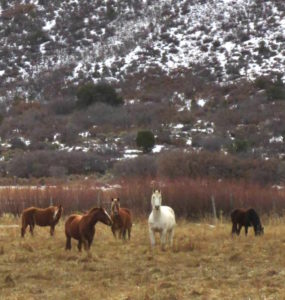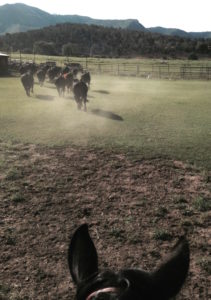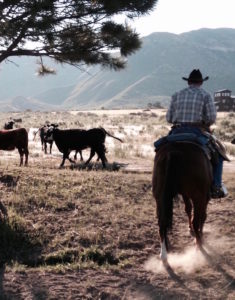Not everyone thinks cowboys are the pillars of good horsemanship. In some quarters, they have a historical reputation of neglectful, even abusive handling and care.
 But as an observer of several years, I can testify to the contrary. Indeed, on average, I’ve seen better care out here in the West than I have in New England. (My status as proud Maine native notwithstanding.)
But as an observer of several years, I can testify to the contrary. Indeed, on average, I’ve seen better care out here in the West than I have in New England. (My status as proud Maine native notwithstanding.)
Why?
As Elijah Moore, a Utah horseman who’s lived in Maine for 30 years, told me once: folks in the East love their horses to death.
- Owners like to put them in stalls.
- They like to blanket them and give them grain.
- They like to separate them into individual quarters.
These are all management and care decisions that go against “what nature intended.” The strategies also go against what current research tells us is best. Martin Black and Dr. Steve Peters, co-authors of Evidence-Based Horsemanship, will discuss best practices at their November  seminar.
seminar.
There are, of course, plenty of New Englanders who keep their horses simply and naturally. But I’ve found those owners almost apologetic that their routine is so low maintenance. One Maine acquaintance called her care “affectionate neglect,” as if her neighbors thought spending more time and money would necessarily be better for horses.
There is no apology here:
- Most horses live in pastures with their buddies.
- They eat hay, grass, and little else.
- They have access to water, a salt block, and (sometimes but not always) shelter.
They seem content and look healthy.
There’s also something to be said for the life of a working horse and the mentality of a working cowboy.
I had the privilege of helping move cattle several times this summer. I experienced first hand what every clinician tells me: jobs can benefit the horse and rider partnership tremendously. Indeed, side-passing, galloping, long trotting, quick starts and stops all came more easily when the focus was on something else.
Cow work demands mindfulness and an ability to adjust to what each situation brings you. Last weekend, I headed out with my friend, Tom, to move about fifty head. He said, “I don’t have a plan.”
Tom did have a plan, of course, but what he expressed was the need to make spontaneous choices and changes depending on the cows, the road traffic, and whatever else came up.
Being in the moment is an essential aspect of successful horsemanship. Just ask WiseAssWallace.
I chatted with Peters and Black about it. Coincidentally, Peters had just reviewed research for his day job as a neuropsychologist for Intermountain Healthcare. He said humans generally take one of three approaches to accomplish a task:
- They’re on automatic pilot. (Just going through the motions.)
- They follow a rules-based approach (Do A, then B.)
- They use a knowledge-based approach, requiring awareness and flexibility. It’s a problem-solving mode that can adapt to novel situations.
Not surprisingly, he said, the greatest number of hospital errors occurs with a rules-based approach. Black said he sees the same pattern with horsemanship successes and failures.
My friend, Tom? He clearly uses the knowledge-based approach.

Maddy it so great to read this article from your experience of having a job to do with your horse. It makes all the difference in communication when we are working towards something, such as moving cattle. You learn quickly where your holes are in horsemanship. The livestock help both rider and horse learn to feel of the natural instincts of these incredible animals.
Thanks for sharing your view of a day working with your friend Tom.
Maddy, I was so happy to read this. Your experience mirrors my own. I grew up in Germany, where horses lived in box stalls and hardly ever got turned out. I came to New Mexico at age 19 because I wanted to become a cowgirl, and spent lots of time on ranches in a Western saddle before revisiting dressage. Yes, there are Western show trainers who abuse horses. I’ve worked for some. But these people are not cowboys. I was lucky to learn colt starting from a real cowboy, who cared about horses more deeply than he cared about most people. And the point about the horse having a job to do is an excellent one – it’s the main difference between Western and Dressage riding, really. Thank you! Katrin
This is such a great article. I grew up in the Midwest and later moved to the east coast. There is a huge difference in how people “care” for their horses. I was used to them living in large field with their buddies. This can happen on the east coast but I mostly met horses that were sequestered.
Great to hear your observations. Thanks for your comment, Elizabeth.